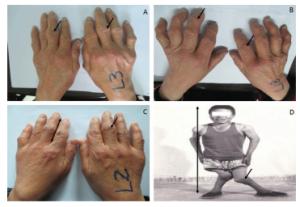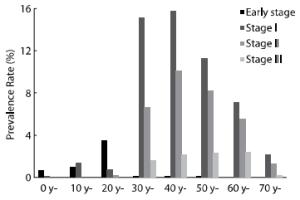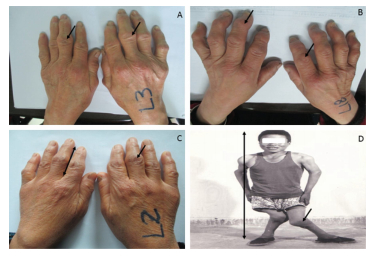-
Kashin-Beck disease (KBD) is an endemic, chronic, and degenerative form of osteoarthritis, characterized by deformity and disability[1-3]. KBD occurs most commonly in children aged 5-15 years and is characterized by the degeneration and necrosis of epiphyseal plate cartilage as well as articular cartilage at several other locations in the developing skeleton. The clinical syndrome includes joint pain and enlargement, restricted movement, short fingers, and dwarfism. Severe patients experience a loss of capacity for physical labor in adulthood and lifelong disability[4-5]. A previous study has described 20 clinical symptoms and four radiological signs in various joints of 2, 560 KBD patients from endemic and non-endemic areas in China[6]. It has been suggested that the symptoms should be classified into the following five groups, representing the manifestations of KBD: flexion of the distal joint of fingers or deformed fingers, arthritic pain in the knee and ankle joints, enlargement of small-and middle-sized joints, limited motion in affected joints with deformity, and retarded growth[7-10].
Appropriate diagnostic criteria are important for the surveillance, prevention, control, and elimination of KBD. In 1995, the National Health and Family Planning Commission of the People's Republic of China promulgated and implemented 'Diagnosis Criteria for Kashin-Beck Disease (GB16003-1995)'[11]. These criteria were developed by the Ministry of Health based on KBD research data collected since 1956, diagnostic criteria of KBD research consortium (three northeast provinces) since 1972, diagnostic criteria of the central endemic disease office since 1983, and the Yongshou study group of clinical diagnosis and X-ray diagnostic criteria since 1984[12]. These criteria (GB16003-1995) have been employed for surveillance, therapy, and research for 15 years. In 2010, the National Health and Family Planning Commission of the People's Republic of China promulgated and implemented new 'Diagnostic Criteria for Kashin-Beck Disease (WS/T207-2010)'[13]. This new criteria integrated and revised both 'Diagnostic Criteria for Kashin-Beck Disease (GB16003-1995)'[14] and 'X-ray classification indexing for Kashin-Beck disease (WS/T207-2001)' (Table 1). The new diagnosis criteria (WS/T207-2010) were convenient and simple for epidemiological surveillance and had extensive clinical applications.
Table 1. The Two Different Diagnostic Criteria of Kashin-Beck Disease
Criterion KBD Endemic Areas, Clinical Symptoms, and X-ray Signs GB16003-1995 (gold criterion) Early stage Mild limited and pain in hand, wrist, knee and ankle joint, multiple symmetric flexion of distal part of fingers, metaphyseal lesions in phalanges Ⅰ stage Multiple symmetric enlarged finger joints, restricted stretch, mild muscle atrophy and clinical symptoms of early stage, metaphyseal or epiphyseal lesions in phalanges Ⅱ stage Shortened fingers and clinical symptoms of first stage, early closure of epiphysial plate in phalanges Ⅲ stage Dwarfism and clinical symptoms of second stage, aggravated metaphyseal lesions in phalanges WS/T207-2010 (new criterion) Ⅰ stage Enlarged finger joints, limited and pain in the joints of the limbs Ⅱ stage Shortened fingers and clinical symptoms of first stage Ⅲ stage Dwarfism and clinical symptoms of second stage This study aimed to evaluate the sensitivity and specificity of the new clinical diagnostic and classification criteria for KBD compared with those of the old criteria (GB16003-1995). We sampled 3, 459 KBD patients in Yongshou County using the new 'Diagnostic Criteria for Kashin-Beck Disease (GB16003-1995)' in 2002. Subsequently, we performed a screening test for six clinical symptoms in this population (n=25, 304) using the new 'Diagnostic Criteria for Kashin-Beck Disease (WS/T207-2010)' to determine its sensitivity and specificity.
-
This study was conducted in 110 villages in Linyou County in 2002. Stratified random sampling was performed according to the prevalence of KBD in the villages. The 110 villages in Linyou County were divided into three groups: 13 low-prevalence villages ( < 10%), 42 medium-prevalence villages (10%-20%), and 55 high-prevalence villages ( > 20%). One-third of the villages in each group were sampled: 36 villages, including four low-prevalence villages, 14 medium-prevalence villages, and 18 high-prevalence villages. In total, 25, 304 individuals were surveyed, and all participants provided written informed consent according to the Declaration of Helsinki. Ethical approval on the research was obtained from the Xi'an Jiaotong University.
-
We surveyed baseline characteristics and clinical diagnosis in accordance with the research objective. Baseline characteristics included name, sex, age, ethnicity, occupation, and age at the incidence. Clinical diagnosis included flexion of the distal part of fingers, deformed fingers, enlarged finger joints, shortened fingers, squat down, and dwarfism (Figure 1). We first identified 3, 459 KBD patients using the old 'Diagnostic Criteria for Kashin-Beck Disease (GB16003-1995)'. Subsequently, we performed a screening test using the new 'Diagnostic Criteria for Kashin-Beck Disease (WS/T207-2010)' (Table 1), and evaluated the sensitivity and specificity of the new criteria.

Figure 1. The KBD patients were classified as stages Ⅰ, Ⅱ, or Ⅲ KBD using the new diagnostic criteria for Kashin-Beck disease (WS/T207-2010). Stage Ⅰ KBD is depicted in A (enlarged finger joints) and B (enlarged finger joints and flexion of the distal part of fingers), stage Ⅱ KBD is depicted in C (shortened fingers and enlarged finger joints), and stage Ⅲ KBD is depicted in D (dwarfism).
-
(ⅰ) Shortened fingers: The phalanges of healthy participants and patients with developmental disorder were compared. We found that the axis length of phalanges of patients was much shorter (25%±2.5%) than the axis length of phalanges of healthy participants. (ⅱ) Deformed fingers: Fingers with different directions of skew were termed as 'deformed'. (ⅲ) Enlarged finger joints: The finger joints of patients with bony enlargements and multiple clinical signs were considered as 'enlarged'. (ⅳ) Flexion of the distal part of fingers: Distal flexion occurred more commonly in the Ⅱ, Ⅲ, and Ⅳ fingers. Straight fingers were parallel to the view of inspection, and physical examination was not performed at cold temperatures.
-
Data entry and statistical analyses were performed using the Excel and the SPSS version 16.0 software packages (IBM Corporation, United States). Sensitivity refers to the test's ability to correctly detect KBD patients with clinical symptoms. Mathematically, this can be calculated as follows: Sensitivity=Number of true positives / (Number of true positives + Number of false negatives). Specificity relates to the test's ability to correctly detect KBD patients without clinical symptoms. Mathematically, this can be calculated as follows: Specificity=Number of true negatives / (Number of true negatives + Number of false positives)[15]. The Youden index represents the total ability of the screening test to identify true patients and non-patients. It can be calculated using the following formula: The Youden index=Sensitivity + Specificity-1. A larger Youden index value indicates higher diagnostic accuracy[16].
-
We conducted a sampling survey of one-third of the total population in Linyou County, where the investigated 25, 304 Han Chinese patients were belonged to farming families. We identified 3, 459 KBD patients [1, 953 males (56.5%) and 1, 506 females (43.5%); average age, 46±14 years] based on the history and clinical examination using the old 'Diagnostic Criteria of Kashin-Beck Disease (GB16003-1995)'. The 3, 459 KBD patients were classified into four stages: early stage (69 patients), stage Ⅰ (1, 952 patients), stage Ⅱ (1, 132 patients), and stage Ⅲ (306 patients). The population of 21, 845 healthy people included 11, 305 males (51.8%) and 10, 540 females (48.2%) with average age of 39±18 years (Table 2). The age distribution revealed that the peak prevalence of KBD was at 40-49 years of age, with more than 25% prevalence rate, where as KBD patients of 0-19 years had lower prevalence rate ( < 5%) (Figure 2). The majority of patients had stage Ⅰ KBD (56.4%), followed by stage Ⅱ KBD (32.7%), and stage Ⅲ (8.8%). The ratio of stages Ⅰ, Ⅱ, and Ⅲ KBD was approximately 6:3:1.
Table 2. The Baseline Characteristics of a Screening Population in Linyou Contry
Groups Kashin-Beck Disease Healthy Early Stage Ⅰ Stage Ⅱ Stage Ⅲ Stage Total Sex (n) Male/female 49/20 1, 066/886 670/462 168/138 1, 953/1, 506 11, 305/10, 540 Occupation (n) Farmer 69 1, 952 1, 132 306 3, 459 21, 845 Racial (n) Han Chinese 69 1, 952 1, 132 306 3, 459 21, 845 Age Mean±SD 15±12 45±13 49±12 51±12 46±14 39±18 -
We measured the incidence of six clinical symptoms (flexion of the distal part of fingers, deformed fingers, enlarged finger joints, shortened fingers, squat down, and dwarfism) in different groups summarized in Table 3. There were 3, 394 subjects (96.8%) with enlarged finger joints, 1, 609 (46.5%) with flexion of the distal part of fingers, 1, 491 (43.1%) with deformed fingers, 1, 460 (42.2%) with shortened fingers, 1, 212 (35.0%) with squat down, and 315 (9.1%) with dwarfism. The difference in the incidence of six clinical symptoms was significant between the KBD and healthy populations (P < 0.001). The most common clinical symptom was flexion of the distal part of fingers (85.5%) in early stage KBD, enlarged finger joints (97.8%) in stage IKBD, enlarged finger joints (99.4%) in stage Ⅱ KBD, and shortened fingers (99.3%) in stage Ⅲ KBD.
Table 3. Incidence of the Six Clinical Symptoms in the Screening Population in Linyou Country
Groups No. Flexion of Distal
Part of Fingers (%)Deformed
Fingers (%)Enlarged Finger
Joints (%)Shortened Fingers
(%)Squat Down
(%)Dwarfism
(%)Healthy 21, 845 123 (0.6) 135 (0.6) 9 (0) 2 (0) 28 (0.1) 2 (0) KBD 3, 459 1, 609 (46.5) 1, 491 (43.1) 3, 349 (96.8) 1, 460 (42.2) 1, 212 (35.0) 315 (9.1) Early stage 69 59 (85.5) 34 (49.3) 14 (20.3) 1 (1.4) 5 (7.2) 0 (0.0) Ⅰ stage 1, 952 714 (36.6) 613 (31.4) 1, 910 (97.8) 58 (3.0) 296 (15.2) 4 (0.2) Ⅱ stage 1, 132 660 (58.3) 658 (58.1) 1, 125 (99.4) 1, 097 (96.9) 618 (54.6) 20 (1.8) Ⅲ stage 306 176 (57.5) 186 (60.8) 300 (98.0) 304 (99.3) 293 (95.8) 291 (95.1) -
Subsequently, we performed a screening test (Table 4) using the new 'Diagnostic Criteria for Kashin-Beck Disease (WS/T207-2010)', which included three clinical symptoms: enlarged finger joints, shortened fingers, and dwarfism. Enlarged finger joints were used to diagnose KBD with a sensitivity, specificity, and Youden index of 0.968, 1.000, and 0.968, respectively. Enlarged finger joints were used to classify stage Ⅰ KBD with a sensitivity, specificity, and Youden index of 0.978, 0.045, and 0.023, respectively. Shortened fingers were used to classify stage Ⅱ KBD with a sensitivity, specificity, and Youden index of 0.969, 0.844, and 0.813, respectively. Dwarfism was used to classify stage Ⅲ KBD, with a sensitivity, specificity and Youden index of 0.951, 0.992, and 0.943, respectively. In a serial test (Table 5), enlarged finger joints without shortened fingers and dwarfism were used to classify stage Ⅰ KBD with a sensitivity, specificity and Youden index of 0.949, 0.967, and 0.916, respectively. Shortened fingers with enlarged finger joints were used to classify stage Ⅱ KBD with a sensitivity, specificity, and Youden index of 0.945, 0.970, and 0.915, respectively. Dwarfism with shortened fingers and enlarged finger joints were used to classify stage Ⅲ KBD with a sensitivity, specificity, and Youden index of 0.925, 0.993, and 0.918, respectively.
Table 4. The Sensitivity and Specificity of the Six Clinical Symptoms for the New Clinical Diagnosis and Classification Criterion of Kashin-Beck Disease in a Screening Test
Clinical Classification Flexion of Distal Part of Fingers Deformed Fingers Enlarged Finger Joints Shortened Fingers Squat Down Dwarfism KBD Sensitivity 0.465 0.431 0.968 0.422 0.350 0.091 Specificity 0.994 0.994 1.000 1.000 0.999 1.000 Youden's index 0.459 0.425 0.968 0.422 0.349 0.091 Ⅰ stage Sensitivity 0.366 0.314 0.978 0.030 0.152 0.002 Specificity 0.406 0.417 0.045 0.070 0.392 0.794 Youden's index -0.228 -0.269 0.023 -0.900 -0.456 -0.204 Ⅱ stage Sensitivity 0.583 0.581 0.994 0.969 0.546 0.018 Specificity 0.592 0.642 0.044 0.844 0.745 0.873 Youden's index 0.175 0.223 0.038 0.813 0.291 -0.109 Ⅲ stage Sensitivity 0.575 0.608 0.980 0.993 0.958 0.951 Specificity 0.546 0.586 0.033 0.633 0.709 0.992 Youden's index 0.121 0.194 0.013 0.626 0.667 0.943 Table 5. A Serial Screening Test of the New Clinical Classification Criterion of Kashin-Beck Disease
Clinical Classification Sensitivity Specificity Youden's Index Ⅰ stage (Enlarged finger joints without shortened fingers and dwarfism) 0.949 0.967 0.916 Ⅱ stage (Shortened fingers with enlarged finger joints) 0.945 0.970 0.915 Ⅲ stage (Dwarfism with shortened fingers, enlarged finger joints) 0.925 0.993 0.918 The 'Diagnostic Criteria for Kashin-Beck Disease (GB16003-1995)' was employed for more than 15 years, and the new version 'Diagnostic Criteria for Kashin-Beck Disease (WS/T207-2010)' was issued in 2010. The new criteria simplified the classification of KBD from four to three stages, creating a simple and practical system. For the screening test in this study, 25, 304 Han Chinese people were sampled and 3, 459 KBD patients were identified using the old criteria (GB16003-1995). Further, we selected KBD patients using the new criteria (WS/T207-2010) with six clinical symptoms. Subsequently, we evaluated the sensitivity and specificity of three clinical symptoms in the clinical classification of KBD using the serial test.
We identified 3, 459 patients using the old criteria with an average age of 46 years. The proportion of patients with stages Ⅰ, Ⅱ, and Ⅲ KBD was approximately 6:3:1. We selected six clinical symptoms (flexion of the distal part of fingers, deformed fingers, enlarged finger joints, shortened fingers, squat down, and dwarfism) according to the previous studies[2, 17-18]. We identified 96.8% subjects with enlarged finger joints, 46.5% with flexion of distal part of fingers, 43.1% with crooked fingers, 42.2% with short fingers, 35.0% with squat down, and 9.1% with dwarfism. Subsequently, we performed a screening test using the new criteria, including enlarged finger joints, shortened fingers, and dwarfism, to classify stages Ⅰ, Ⅱ, and Ⅲ KBD with high sensitivity. Enlarged finger joints occurring in 96.8% KBD patients was used to classify stage Ⅰ KBD with lower specificity. Therefore, we performed a serial test in which enlarged finger joints without shortened fingers and dwarfism, shortened fingers with enlarged finger joints, and dwarfism with shortened fingers and enlarged finger joints were used to classify stages Ⅰ, Ⅱ, and Ⅲ KBD, respectively, with high sensitivity and specificity.
The new diagnostic criteria (WS/T207-2010) represent a simplified version of the old diagnostic criteria (GB16003-1995) with higher sensitivity and specificity than the old diagnostic criteria (Table 1). The four stages of classification in the old diagnostic criteria was revised to three stages in the new diagnosis criteria, and the new diagnostic criteria also removed some of the clinical signs from the old diagnostic criteria (Table 1). Therefore, the new diagnostic criteria are convenient for epidemiological surveillance and have extensive clinical applications.
This study has two limitations. First, the new diagnostic criteria were used to screen KBD patients in endemic areas. The old diagnostic criteria were also applicable to only endemic areas and excluded other areas, and the screening test in the new diagnostic criteria was based on the old diagnostic criteria. Second, screening personnel required professional training to adequately perform the epidemiological surveillance of KBD patients. Therefore, the new diagnostic criteria can be used to screen endemic population only by professionally trained screening personnel.
In summary, we identified 3, 459 KBD patients, of which 69 were classified as early stage KBD, 1, 952 as stage Ⅰ KBD, 1, 132 as stage Ⅱ KBD, and 306 as stage Ⅲ KBD. The screening and serial tests revealed that enlarged finger joints, shortened fingers, and dwarfism can be used to classify stages Ⅰ, Ⅱ, and Ⅲ KBD with high sensitivity ( > 0.9) and specificity ( > 0.9).
doi: 10.3967/bes2017.021
Evaluation of the Sensitivity and Specificity of the New Clinical Diagnostic and Classification Criteria for Kashin-Beck Disease, an Endemic Osteoarthritis, in China
-
Abstract: This study aimed to evaluate the sensitivity and specificity of the new clinical diagnostic and classification criteria for Kashin-Beck disease (KBD) using six clinical markers: flexion of the distal part of fingers, deformed fingers, enlarged finger joints, shortened fingers, squat down, and dwarfism. One-third of the total population in Linyou County was sampled by stratified random sampling. The survey included baseline characteristics and clinical diagnoses, and the sensitivity and specificity of the new criteria was evaluated. We identified 3, 459 KBD patients, of which 69 had early stage KBD, 1, 952 had stage Ⅰ, 1, 132 had stage Ⅱ, and 306 had stage Ⅲ. A screening test classified enlarged finger joints as stage Ⅰ KBD, with a sensitivity and specificity of 0.978 and 0.045, respectively. Shortened fingers were classified as stage Ⅱ KBD, with a sensitivity and specificity of 0.969 and 0.844, respectively, and dwarfism was classified as stage Ⅲ KBD with a sensitivity and specificity of 0.951 and 0.992, respectively. Serial screening test revealed that the new clinical classification of KBD classified stages Ⅰ, Ⅱ, and Ⅲ KBD with sensitivities of 0.949, 0.945, and 0.925 and specificities of 0.967, 0.970, and 0.993, respectively. The screening tests revealed that enlarged finger joints, shortened fingers, and dwarfism were appropriate markers for the clinical diagnosis and classification of KBD with high sensitivity and specificity.
-
Figure 1. The KBD patients were classified as stages Ⅰ, Ⅱ, or Ⅲ KBD using the new diagnostic criteria for Kashin-Beck disease (WS/T207-2010). Stage Ⅰ KBD is depicted in A (enlarged finger joints) and B (enlarged finger joints and flexion of the distal part of fingers), stage Ⅱ KBD is depicted in C (shortened fingers and enlarged finger joints), and stage Ⅲ KBD is depicted in D (dwarfism).
Table 1. The Two Different Diagnostic Criteria of Kashin-Beck Disease
Criterion KBD Endemic Areas, Clinical Symptoms, and X-ray Signs GB16003-1995 (gold criterion) Early stage Mild limited and pain in hand, wrist, knee and ankle joint, multiple symmetric flexion of distal part of fingers, metaphyseal lesions in phalanges Ⅰ stage Multiple symmetric enlarged finger joints, restricted stretch, mild muscle atrophy and clinical symptoms of early stage, metaphyseal or epiphyseal lesions in phalanges Ⅱ stage Shortened fingers and clinical symptoms of first stage, early closure of epiphysial plate in phalanges Ⅲ stage Dwarfism and clinical symptoms of second stage, aggravated metaphyseal lesions in phalanges WS/T207-2010 (new criterion) Ⅰ stage Enlarged finger joints, limited and pain in the joints of the limbs Ⅱ stage Shortened fingers and clinical symptoms of first stage Ⅲ stage Dwarfism and clinical symptoms of second stage Table 2. The Baseline Characteristics of a Screening Population in Linyou Contry
Groups Kashin-Beck Disease Healthy Early Stage Ⅰ Stage Ⅱ Stage Ⅲ Stage Total Sex (n) Male/female 49/20 1, 066/886 670/462 168/138 1, 953/1, 506 11, 305/10, 540 Occupation (n) Farmer 69 1, 952 1, 132 306 3, 459 21, 845 Racial (n) Han Chinese 69 1, 952 1, 132 306 3, 459 21, 845 Age Mean±SD 15±12 45±13 49±12 51±12 46±14 39±18 Table 3. Incidence of the Six Clinical Symptoms in the Screening Population in Linyou Country
Groups No. Flexion of Distal
Part of Fingers (%)Deformed
Fingers (%)Enlarged Finger
Joints (%)Shortened Fingers
(%)Squat Down
(%)Dwarfism
(%)Healthy 21, 845 123 (0.6) 135 (0.6) 9 (0) 2 (0) 28 (0.1) 2 (0) KBD 3, 459 1, 609 (46.5) 1, 491 (43.1) 3, 349 (96.8) 1, 460 (42.2) 1, 212 (35.0) 315 (9.1) Early stage 69 59 (85.5) 34 (49.3) 14 (20.3) 1 (1.4) 5 (7.2) 0 (0.0) Ⅰ stage 1, 952 714 (36.6) 613 (31.4) 1, 910 (97.8) 58 (3.0) 296 (15.2) 4 (0.2) Ⅱ stage 1, 132 660 (58.3) 658 (58.1) 1, 125 (99.4) 1, 097 (96.9) 618 (54.6) 20 (1.8) Ⅲ stage 306 176 (57.5) 186 (60.8) 300 (98.0) 304 (99.3) 293 (95.8) 291 (95.1) Table 4. The Sensitivity and Specificity of the Six Clinical Symptoms for the New Clinical Diagnosis and Classification Criterion of Kashin-Beck Disease in a Screening Test
Clinical Classification Flexion of Distal Part of Fingers Deformed Fingers Enlarged Finger Joints Shortened Fingers Squat Down Dwarfism KBD Sensitivity 0.465 0.431 0.968 0.422 0.350 0.091 Specificity 0.994 0.994 1.000 1.000 0.999 1.000 Youden's index 0.459 0.425 0.968 0.422 0.349 0.091 Ⅰ stage Sensitivity 0.366 0.314 0.978 0.030 0.152 0.002 Specificity 0.406 0.417 0.045 0.070 0.392 0.794 Youden's index -0.228 -0.269 0.023 -0.900 -0.456 -0.204 Ⅱ stage Sensitivity 0.583 0.581 0.994 0.969 0.546 0.018 Specificity 0.592 0.642 0.044 0.844 0.745 0.873 Youden's index 0.175 0.223 0.038 0.813 0.291 -0.109 Ⅲ stage Sensitivity 0.575 0.608 0.980 0.993 0.958 0.951 Specificity 0.546 0.586 0.033 0.633 0.709 0.992 Youden's index 0.121 0.194 0.013 0.626 0.667 0.943 Table 5. A Serial Screening Test of the New Clinical Classification Criterion of Kashin-Beck Disease
Clinical Classification Sensitivity Specificity Youden's Index Ⅰ stage (Enlarged finger joints without shortened fingers and dwarfism) 0.949 0.967 0.916 Ⅱ stage (Shortened fingers with enlarged finger joints) 0.945 0.970 0.915 Ⅲ stage (Dwarfism with shortened fingers, enlarged finger joints) 0.925 0.993 0.918 -
[1] Guo X, Ma WJ, Zhang F, et al. Recent advances in the research of an endemic osteochondropathy in China:Kashin-Beck disease. Osteoarthritis Cartilage, 2014; 22, 1774-83. doi: 10.1016/j.joca.2014.07.023 [2] Huang Q, Zhou ZK, Ma J, et al. The arthropathic and functional impairment features of adult Kashin-Beck disease patients in Aba Tibetan area in China. Osteoarthritis Cartilage, 2015; 23, 601-6. doi: 10.1016/j.joca.2015.01.005 [3] Han J, Yu FF, Chang ZP, et al. Changing grains for the prevention and treatment of Kashin-Beck disease in children:a meta-analysis. Biomed Environ Sci, 2015; 28, 308-11. http://www.cnki.com.cn/Article/CJFDTOTAL-SWYX201504009.htm [4] Li Y, Zhou Z, Shen B, et al. Clinical features of Kashin-Beck disease in adults younger than 50 years of age during a low incidence period:severe elbow and knee lesions. Clin Rheu matol, 2013; 32, 317-24. doi: 10.1007/s10067-012-2115-0 [5] Cao CX, Zhang YG, Wu SX, et al. Association of clinical features of bone and joint lesions between children and parents with Kashin-Beck disease in Northwest China. Clin Rheumatol, 2013; 32, 1309-16. doi: 10.1007/s10067-013-2267-6 [6] Xiong G. Diagnostic, clinical and radiological characteristics of Kashin-Beck disease in Shaanxi Province, PR China. Int Orthop, 2001; 25, 147-50. doi: 10.1007/s002640100248 [7] Wang Y, Yang Z, Gilula LA, et al. Kashin-Beck disease:radiographic appearance in the hands and wrists. Radiology, 1996; 201, 265-70. doi: 10.1148/radiology.201.1.8816556 [8] Fu Q, Cao J, Renner JB, et al. Radiographic features of hand osteoarthritis in adult Kashin-Beck Disease (KBD):the Yongshou KBD study. Osteoarthritis Cartilage, 2015; 23, 868-73. doi: 10.1016/j.joca.2015.01.009 [9] Shi XW, Shi BH, LvA L, et al. Exploring Genome-wide DNA Methylation Profiles Altered in Kashin-Beck Disease Using Infinium Human Methylation 450 Bead Chips. Biomed Environ Sci, 2016; 29, 539-43. doi: 10.4161/epi.23062 [10] Yang GQ, Xia YM. Studies on human dietary requirements and safe range of dietary intakes of selenium in China and their application in the prevention of related endemic diseases. Biomed Environ Sci, 1995; 8, 187-201. https://www.researchgate.net/publication/14638445_Studies_on_human_dietary_requirements_and_safe_range_of_dietary_intakes_of_selenium_in_China_and_their_application_in_the_prevention_of_related_endemic_diseases [11] Yang JB, Wang ZW, Liu JW, et al. Criteria of diagnosis for Kashin-Beck disease. Chin J Endemicol, 1994; 13, 309. (In Chinese) [12] Liu N. The interpretation of criteria of diagnosis for Kashin-Beck disease. China health standard management, 2010; 4, 56-8. (In Chinese) [13] National Health and Family Planning Commission of the People's Republic of China. Diagnosis of Kashin-Beck disease (WS/T207-2010).[2010-06-02] [14] National Health and Family Planning Commission of the People's Republic of China. Diagnostic criteria of Kashin-Beck disease (GB16003-1995).[1995-12-15] [15] Smith CJ. Diagnostic tests (1)-sensitivity and specificity. Phlebology, 2012; 27, 250-1. doi: 10.1258/phleb.2012.012J05 [16] Hughes G. Youden's Index and the Weight of Evidence. Methods Inf Med, 2015; 54, 198-9. doi: 10.3414/ME14-04-0003 [17] Nesterov AI. The clinical course of Kashin-Beck disease. Arthritis & Rheumatism, 1964; 7, 29-40. https://www.researchgate.net/publication/9461082_The_clinical_course_of_Kashin-Beck_Disease [18] Mathieu F, Begaux F, Lan ZY, et al. Clinical manifestations of Kashin-Beck disease in Nyemo valley, Tibet. Int Orthop, 1997; 21, 151-6. doi: 10.1007/s002640050139 -




 下载:
下载:





 Quick Links
Quick Links